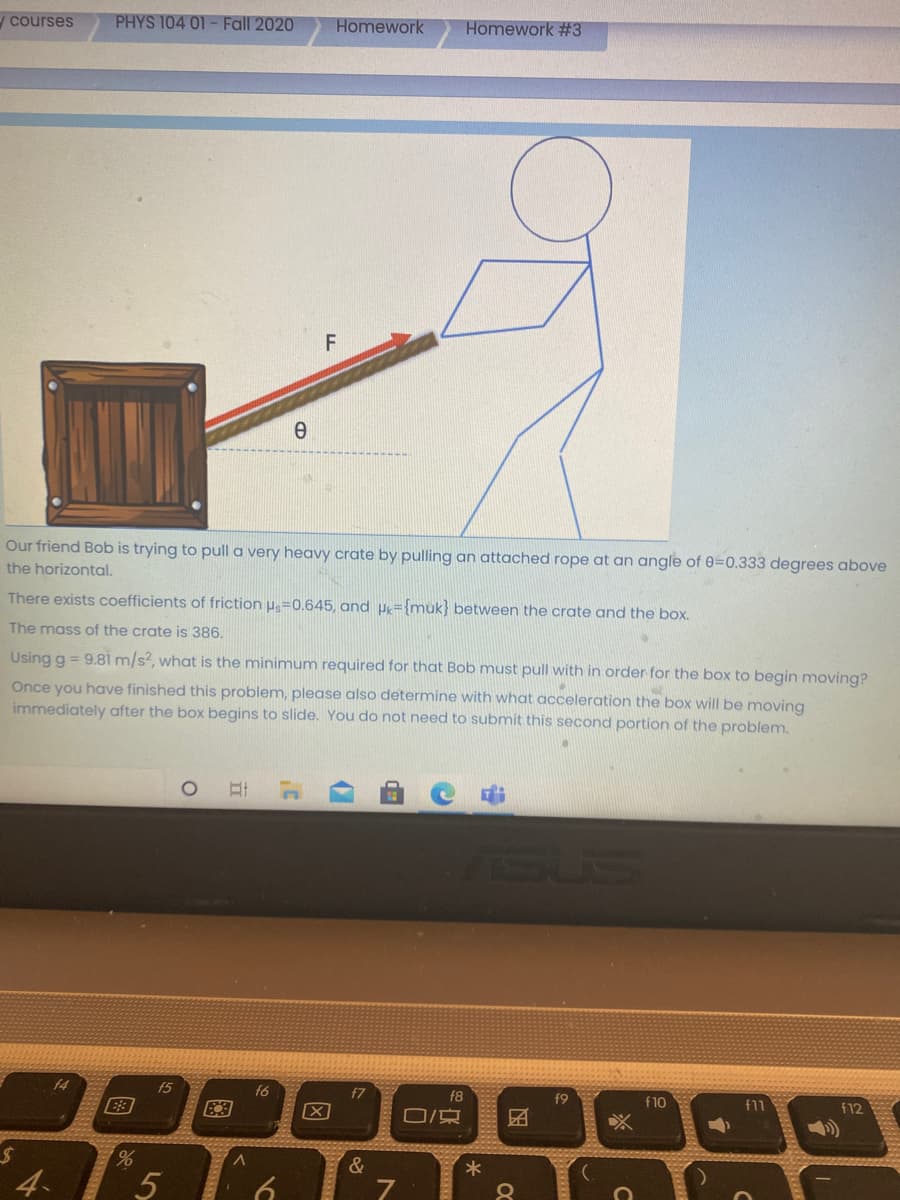Our friend Bob is trying to pull a very heavy crate by pulling an attached rope at an angle of 0=0.333 degrees above the horizontal. There exists coefficients of friction u,=0.645, and P={muk} between the crate and the box. The mass of the crate is 386. Using g = 9.81 m/s?, what is the minimum required for that Bob must pull with in order for the box to begin moving? %3D Once you have finished this problem, please also determine with what acceleration the box will be moving immediately after the box begins to slide. You do not need to submit this second portion of the problem.
Our friend Bob is trying to pull a very heavy crate by pulling an attached rope at an angle of 0=0.333 degrees above the horizontal. There exists coefficients of friction u,=0.645, and P={muk} between the crate and the box. The mass of the crate is 386. Using g = 9.81 m/s?, what is the minimum required for that Bob must pull with in order for the box to begin moving? %3D Once you have finished this problem, please also determine with what acceleration the box will be moving immediately after the box begins to slide. You do not need to submit this second portion of the problem.
Physics for Scientists and Engineers: Foundations and Connections
1st Edition
ISBN:9781133939146
Author:Katz, Debora M.
Publisher:Katz, Debora M.
Chapter5: Newton's Laws Of Motion
Section: Chapter Questions
Problem 72PQ: A block of ice (m = 15.0 kg) with an attached rope is at rest on a frictionless surface. You pull...
Related questions
Topic Video
Question

Transcribed Image Text:ycourses
PHYS 104 01- Fall 2020
Homework
Homework #3
Our friend Bob is trying to pull a very heavy crate by pulling an attached rope at an angle of 0=0.333 degrees above
the horizontal.
There exists coefficients of friction u=0.645, and µy={muk} between the crate and the box.
The mass of the crate is 386.
Using g = 9.81 m/s?, what is the minimum required for that Bob must pull with in order for the box to begin moving?
Once you have finished this problem, please also determine with what acceleration the box will be moving
immediately after the box begins to slide. You do not need to submit this second portion of the problem.
SUS
f4
f5
f6
f7
f8
f9
f10
f11
f12
E3
&
4
国
因
5
图
Expert Solution
This question has been solved!
Explore an expertly crafted, step-by-step solution for a thorough understanding of key concepts.
Step by step
Solved in 3 steps with 3 images

Knowledge Booster
Learn more about
Need a deep-dive on the concept behind this application? Look no further. Learn more about this topic, physics and related others by exploring similar questions and additional content below.Recommended textbooks for you

Physics for Scientists and Engineers: Foundations…
Physics
ISBN:
9781133939146
Author:
Katz, Debora M.
Publisher:
Cengage Learning

Physics for Scientists and Engineers, Technology …
Physics
ISBN:
9781305116399
Author:
Raymond A. Serway, John W. Jewett
Publisher:
Cengage Learning

College Physics
Physics
ISBN:
9781285737027
Author:
Raymond A. Serway, Chris Vuille
Publisher:
Cengage Learning

Physics for Scientists and Engineers: Foundations…
Physics
ISBN:
9781133939146
Author:
Katz, Debora M.
Publisher:
Cengage Learning

Physics for Scientists and Engineers, Technology …
Physics
ISBN:
9781305116399
Author:
Raymond A. Serway, John W. Jewett
Publisher:
Cengage Learning

College Physics
Physics
ISBN:
9781285737027
Author:
Raymond A. Serway, Chris Vuille
Publisher:
Cengage Learning

Glencoe Physics: Principles and Problems, Student…
Physics
ISBN:
9780078807213
Author:
Paul W. Zitzewitz
Publisher:
Glencoe/McGraw-Hill

Classical Dynamics of Particles and Systems
Physics
ISBN:
9780534408961
Author:
Stephen T. Thornton, Jerry B. Marion
Publisher:
Cengage Learning

College Physics
Physics
ISBN:
9781305952300
Author:
Raymond A. Serway, Chris Vuille
Publisher:
Cengage Learning